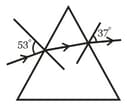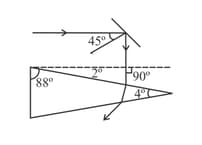Refraction Through a Prism
Refraction Through a Prism: Overview
This topic covers concepts such as Prism and Deviation by Prism.
Important Questions on Refraction Through a Prism
A ray incident at angle 53o on a prism emerges at an angle at 37o as shown. If the angle of incidence is made 50o, which of the following is a possible value of the angle of emergence.

A parallel beam of light falls normaly on the first face of a prism of small angle. At the second face it is partly transmitted and partly reflected, the reflected beam striking at the first face again, and emerging from it in a direction making an angle 6o 30' with the reversed direction of the incident beam. The refracted beam is found to have undergone a deviation of 1o 15' from the original direction. Find the refractive index of the glass and the angle of the prism.
The refractive indices of the crown glass for violet and red lights are and respectively and those of the flint glass are and respectively. A prism of angle is made of crown glass. A beam of white light is incident at a small angle on this prism. The other thin flint glass prism is combined with the crown glass prism such that net mean deviation is anticlockwise.
A screen is placed normal to the emerging beam at a distance of from the prism combination. Find the distance between red and violet spot on the screen. Which is the topmost colour on screen.
A ray of light undergoes deviation of when incident on an equilateral prism of refractive index What is the angle subtended by the ray inside the prism with the base of the prism is ?
A given ray of light suffers minimum deviation in an equilateral prism . Additional prism and of identical shape and of the same material as are now added as shown in the figure. The ray will now suffer

A given ray of light suffers minimum deviation in an equilateral prism . Additional prism and of identical shape and of the same material as are now added as shown in the figure. The ray will now suffer

The angle of _____ increases with the increase in the angle of prism.
The angle of deviation depends on the refractive index of the glass.
When a beam of white light passes through a prism it gets
For a given prism, the _____ light deviates most and the red light deviates least.
A ray of light passes through an equilateral glass prism in such a manner that the angle of incidence is equal to the angle of emergence and each of these angles is equal to of the angle of the prism. The angle of deviation is
A light ray incidents normally on one surface of an equilateral prism. The angle of deviation of the light ray is (Refractive index of the material of the prism )
A ray passes through an equilateral glass prism such that which is of the prism angle. Then deviation will be -
A thin isosceles prism with angle 4º and refractive index 1.5 is placed inside a transparent tube with water (refractive index ) as shown. The deviation of light whether upward or downward due to prism will be in degree is ….. × 10–1.

A certain thin prism is found to produce a minimum deviation of and produces a deviation of when the angle of incidence is either or . The angle of incidence when light undergoes minimum deviation in degree is,
A ray of light is incident at on one face of a prism of angle and the emergent ray makes with the incident ray. The refractive index of the prism is
The light ray is incident at angle of on a prism of angle After refraction the light rays falls on the other surface at the refractive index of the material of prism and the angle of deviation are given by
A ray of light strikes a plane mirror at an angle of incidence as shown in the figure. After reflection, the ray passes through a prism of refractive index 1.50, whose apex angle is . The angle through which the mirror should be rotated if the total deviation of the ray is to be is.

A prism of refractive index and angle A is placed in the position of minimum deviation. If the angle of minimum deviation is equal to angle A, the value of A is
A ray of light from a liquid is incident on a system of two right-angled prisms of refractive index and as shown. The ray suffers zero deviation when emerges into the air from . The angle of incidence is

